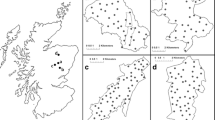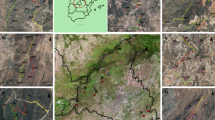Abstract
Reliable estimation of population size remains a major challenge in wildlife ecology and management. Lately, genotyping of non-invasively obtained tissue samples integrated in a modified capture–recapture approach provides new perspectives. Faeces, moulted feathers, or hairs can be easily sampled in the field. However, an important assumption is homogeneity of sampling across the population. In this pilot study, we tested the suitability of baited barbed wire hair sampling stations (‘hair traps’) for homogeneous genetic sampling for population estimation. A video system based on a new network internet protocol was used to observe the behaviour of wild boar visiting baited hair traps for gaining information about potential heterogeneities in the individual sampling probability. Within 92 monitoring nights at two sampling stations, 216 wild boar visits were recorded and 142 hair samples containing 2,124 single hairs were collected. Video analysis revealed distinct differences in the behaviour of wild boar with respect to the sampling station which are most likely to result in heterogeneous individual sampling probabilities. Adult and subadult animals differed in their behaviour dependent on their group status. This result indicates that hair sampling with baited hair traps is not suitable for representative non-invasive sampling of free ranging wild boar populations.



Similar content being viewed by others

References
Acevedo P, Escudero MA, Munoz R, Gortàzar C (2006) Factors affecting wild boar abundance across an environmental gradient in Spain. Acta Theriol 51:327–336
Artois M, Depner KR, Guberti V, Hars J, Rossi S, Rutili D (2002) Classical swine fever (hog cholera) in wild boar in Europe. Rev Sci Tech Off Int Epizoot 21:287–303
Baber DW, Coblentz BE (1986) Density, home range, habitat use, and reproduction in feral pigs on Santa Catalina Island. J Mammal 67:512–525
Baubet E (1998) Biologie du sanglier en montagne: biodémographie, occupation de l’espace et régime alimentaire. Dissertation, University of Lyon [in French]
Beja-Pereira A, Oliveira R, Alves PC, Schwartz MK, Luikart G (2009) Advancing ecological understandings through technological transformations in non-invasive genetics. Mol Ecol Res 9:1279–1301
Bellemain E, Swenson JE, Tallmon D, Brunberg S, Taberlet P (2005) Estimating population size of elusive animals with DNA from hunter-collected feces: four methods for brown bears. Conserv Biol 19:150–161
Boitani L, Trapanese P, Mattei L (1995) Methods of population estimates of a hunted wild boar (Sus scrofa L.) population in Tuscany, Italy. Ibex 3:204–208
Boulanger J, Stenhouse G, Munro R (2004) Sources of heterogeneity bias when DNA mark-recapture sampling methods are applied to grizzly bear (Ursus arctos) populations. J Mammal 85:618–624
Boulanger J, Proctor M, Himmer S, Stenhouse G, Paetkau D, Cranston J (2006) An empirical test of DNA mark-recapture sampling strategies for grizzly bears. Ursus 17:149–158
Boulanger J, Kendall KC, Stetz JC, Roon DA, Waits LP, Paetkau D (2008) Multiple data sources improve DNA-based mark-recapture estimates of grizzly bears. Ecol Appl 18:577–589
Briedermann L (1990) Schwarzwild. VEB Landwirtschaftsverlag, Berlin [in German]
Cahill S, Llimona F, Gràcia J (2003) Spacing and nocturnal activity of wild boar Sus scrofa in a Mediterranean metropolitan park. Wildl Biol 9:3–13
Creel S, Spong G, Sands JL, Rotella J, Zeigle J, Lawrence J, Murphy KM, Smith D (2003) Population size of Yellowstone wolves with error-prone non-invasive microsatellite genotypes. Mol Ecol 12:2003–2009
Fattebert J, Fischer C, Kleijer A, Baubet E, Daendliker G (2004) Wild boar population size estimation in the canton of Geneva. In: Bobek B (ed) 5th International Wild Boar and Suidae Symposium. Abstracts. Krakow, Poland
Fickel J, Hohmann U (2006) A methodological approach for non-invasive sampling for population size estimates in wild boars (Sus scrofa). Eur J Wildl Res 52:28–33
Focardi S, Isotti R, Pelliccioni ER, Iannuzzo D (2002) The use of distance sampling and mark–resight to estimate the local density of wildlife populations. EnvironMetrics 13:177–186
Foran DR, Minta SC, Heinemeyer KS (1997) DNA-based analysis of hair to identify species and individuals for population research and monitoring. Wildl Soc Bull 25(4):840–847
Frantz AC, Schaul M, Pope LC, Fack F, Schley L, Muller CP, Roper TJ (2004) Estimating population size by genotyping remotely plucked hair: the Eurasian badger. J Appl Ecol 41:985–995
Groot Bruinderink GWTA, Hazebroek E (1995) Modelling carrying capacity for wild boar Sus scrofa scrofa in a forest/heathland ecosystem. Wildl Biol 1(2):81–87
Hebeisen C, Fattebert J, Baubet E, Fischer C (2008) Estimating wild boar (Sus scrofa) abundance and density using capture-resight methods with camera traps in conjunction with radio tracking. Eur J Wildl Res 54:391–401
Hromas J (1996) Hog cholera in the Czech Republic. In: Proceedings of the Wild Boar Symposium 24-27.3.1996 in Sopron, Hungary, pp 54-56
Huckschlag D (2008) Development of a digital infrared video camera system for recording and remote capturing. Eur J Wildl Res. doi:10.1007/s10344-008-0191-x
Immel D, Anthony RG (2008) Estimation of black bear abundance using a discrete DNA sampling device. J Wildl Manage 72:324–330
Kaden V (1998) Klassische Schweinepest bei Wildschweinen-Vorkommen in Europa-Möglichkeiten der Seuchenverbreitung in der Schwarzwildpopulation. Amtstierarztlicher Dienst und Lebensmittelkontrolle 5(I/98):62–67
Kaden V (1999) Bekämpfung der klassischen Schweinepest beim Schwarzwild. Z Jagdwiss 45:45–49 [in German]
Kaminski G, Brandt S, Baubet E, Baudoin C (2005) Life-history patterns in female wild boars (Sus scrofa): mother–daughter postweaning associations. Can J Zool 83:474–480
Keuling O, Stier N, Roth M (2007) Annual and seasonal space use of different age classes of female wild boar Sus scrofa L. Eur J Wildl Res 54:403–412
Keuling O, Stier N, Roth M (2008) How does hunting influence activity and spatial usage in wild boar Sus scrofa L.? Eur J Wildl Res 54:729–737
Lukacs PM, Burnham KP (2005) Review of capture-recapture methods applicable to non-invasive genetic sampling. Mol Ecol 14:3909–3919
Maillard D, Fournier P, Fournier-Chambrillon C (1996) Influence of food availability and hunting on wild boar (Sus scrofa L.) home range size in a mediterranean habitat. In: Proceedings of the Wild Boar Symposium 24-27.3.1996 in Sopron, Hungary, pp 69-81
Melis C, Szafrańska PA, Jędrzejewska B, Bartoń K (2006) Biogeographical variation in the population density of wild boar (Sus scrofa) in western Eurasia. J Biogeogr 33:803–811
Miller CR, Joyce P, Waits LP (2005) A new method for estimating the size of small populations from genetic mark–recapture data. Mol Ecol 14:1991–2005
Minta S, Mangel M (1989) A simple population estimate based on simulation for capture–recapture and capture–resight data. Ecol 70:1738–1751
Monaco A, Franzetti B, Pedroti L, Silvano T (2004) Estimating wild boar population size: the inadequacy of “catch per unit effort” methods. In: Bobek B (ed) 5th International Wild Boar and Suidae Symposium. Abstracts. Krakow, Poland
Mowat G, Paetkau D (2002) Estimating marten Martes americana population size using hair capture and genetic tagging. Wildl Biol 8:201–209
Mowat G, Strobeck C (2000) Estimating population size of Grizzly bears using hair capture, DNA profiling, and mark–recapture analysis. J Wildl Manage 64:183–193
Mowat G, Heard DC, Seip DR, Poole KG, Stenhouse G, Paetkau DW (2005) Grizzly Ursus arctos and black bear Ursus americanus densities in the interior mountains of North America. Wildl Biol 11:31–48
Mulders R, Boulanger J, Paetkau D (2007) Estimation of population size for wolverines Gulo gulo at Daring Lake, Northwest Territories, using DNA based mark-recapture methods. Wildl Biol 13 (Suppl. 2): 38–51
Otis DL, Burnham KP, White GC, Anderson DR (1978) Statistical inference for capture-recapture experiments. Wildl Monogr 107
Petit E, Valière N (2005) Estimating population size with non-invasive capture–recapture data. Cons Biol 20:1062–1073
Reis M (2006) Schalenwildbewirtschaftung im Forstamt Hinterweidenthal (Pfälzerwald) in den Jagdjahren 1999/00 bis 2005/06. Diploma Thesis, University for Applied Forest Sciences Rottenburg, Germany [in German]
Sáez-Royuela C, Telleria JL (1986) The increased population of Wild Boar (Sus scrofa L.) in Europe. Mamm Rev 16:97–101
Schnidig-Petrig R, Koller N (2004) Praxishilfe Wildschwein management. Service romand de vulgarisation agricole (SRVA), Lausanne, Schweiz
Settlage KE, Van Manen FT, Clark JD, King TL (2008) Challenges of DNA-based mark–recapture studies of American black bears. J Wildl Manage 72:1035–1042
Sloane MA, Sunnucks P, Alpers D, Behegaray B, Taylor AC (2000) Highly reliable genetic identification of individual northern hairy-nosed wombats from single remotely collected hairs: a feasible censusing method. Mol Ecol 9:1233–1240
Sweitzer R, van Vuren D, Gardner IA, Boyce W, Waithman JD (2000) Estimating sizes of wild pig Populations in the north and central coast regions of California. J Wildl Manage 64:531–543
Taberlet P, Waits LP, Luikart G (1999) Noninvasive genetic sampling: look before you leap. TREE 14:323–327
Truvé J (2004) Pigs in space. Movement, dispersal and geographic expansion of wild boar (Sus scrofa) in Sweden. Dissertation, University of Göteborg; ISBN 91-88376-25-7
Vassant J (1996) Evolution of wild boar populations and damage to crops in France between 1978 and 1993. In: Bobek B (ed) 5th International Wild Boar and Suidae Symposium. Abstracts. Krakow, Poland
Vicente J, Segalés J, Höfle U, Balasch M, Plana-Duràn J, Domingo M, Gortazàr C (2004) Epidemiological study on porcine circovirus type 2 (PCV2) infection in the European wild boar (Sus scrofa). Vet Res 35:243–253
Weiß A (1993) Pflege- und Entwicklungsplan Naturpark Pfälzerwald. Verein Naturpark Pfälzerwald e.V., Bad Dürkheim [in German]
White GC, Andersen DR, Burnham KP, Otis DL (1982) Capture–recapture and removal methods for sampling closed populations. Los Alamos National Laboratory, LA-8787-NERP
Woods JG, Paetkau D, Lewis D, McLellan BN, Proctor M, Strobeck C (1999) Genetic tagging of free-ranging black and brown bears. Wildl Soc Bull 27:616–627
Acknowledgements
We thank Kathrin Berger, Fabian Bartschke, Moritz Fußer, Gerald Scheffler, Rolf Stöbener, and the forest district office of Hinterweidenthal for their support in the field. We are grateful to Uwe Wunn for his help with the statistics and J. Arnold, J. Hofmann and two anonymous reviewers for helpful comments on earlier drafts of this manuscript. The project is supported by the foundation “Rheinland-Pfalz fuer Innovation” and the Ministry of Environment and Forestry, Rhineland-Palatinate. C. Ebert gratefully acknowledges support from the FAZIT foundation. All parts of the study comply with the current German laws.
Author information
Authors and Affiliations
Corresponding author
Additional information
Communicated by: W. Lutz
Rights and permissions
About this article
Cite this article
Ebert, C., Huckschlag, D., Schulz, H.K. et al. Can hair traps sample wild boar (Sus scrofa) randomly for the purpose of non-invasive population estimation?. Eur J Wildl Res 56, 583–590 (2010). https://doi.org/10.1007/s10344-009-0351-7
Received:
Revised:
Accepted:
Published:
Issue Date:
DOI: https://doi.org/10.1007/s10344-009-0351-7



